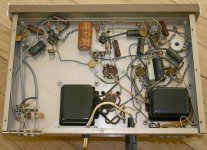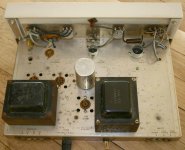If I had a Heathkit amp I'd try it out and compare it with the original 6AN8 splitter to see what sounds the best. It shouldn't be too hard to do the rewiring and fit the few extra components.
Take a look at the circuit. It seems to run the 6AN8 pretty close to the Heathkit setup even if I supply it from a little higher voltage.
What do you think?
Thanks for the split-load circuit, tricomp. When I have the time I might try that. I am curious about the dissimilar value of plate and cathode resistor of the triode section(20k/plate and 40k/cathode). Any mismatched output as in AC balance? What does the voltage divider of 40K and 250K plate resistors and the midpoint joined with 100nF for? Feedback?
High gain at the first tube is not big of a concern to me since I have an extra line-stage, one 6AU6, ahead of the amp and I like the tone color it adds to the sound. Of course a 50k pot might be too low for the line stage to drive. I don't mind flipping the absolute phase either because I can correct that by inverting speaker cables.
That forum thread still doesn't say what's wrong with the 6AN8 and compare to what? To me all the 9-pin pentode/triode combo tubes sound the same to me, whether 6AN8, 7199, 6U8, 6GH8, etc... Just listen to them and make up your own mind. All purists like to point the finger at the line stage or tone control. But the beauty of an integrated amp is the line stage working in tandem with the amp section in harmonious way -- just ask those EICO HF-81 owners. The sound can be better than the sum of its parts.
By the way, I owned the Dyn SCA-35 before. I prefer the Heath, simply because it has more real estate and allows easier mods and tweaks. All good amps, the outcome depends on how much time you want to spend on improving it or accepting what it is.
Enjoy your AA-13.
P.S. I do not like UL operation at high voltage, not for sonic reason but for tube lifespan reason. Designers should respect the ratings in the tube manual regarding screen-grid voltage. Eking out the last drop of wattage has nothing to do with sound quality. Go for quality not quantity. Personally I found ultra-linear can sound wonderful at low voltage and for a tube like 6BQ5, I prefer running it under 300V.
Thx, I'll just leave the 6AN8.
Just out of curiosity, how did you get the 6BQ5 voltage so low? I'm also working on a Sherwood S-5000 and the voltage on the schematic is in the the same range as the AA-13 - around 410v.
Just out of curiosity, how did you get the 6BQ5 voltage so low?
I did not reduce the AA-161 voltage to 300v. I was just saying I would prefer to be that low. On the actual AA-161, I was forced to use a series resistor, 1K 10watt, at the B+ to cut it down to about 365v. 410v at screen is too high for my taste.
Thanks for the split-load circuit, tricomp. When I have the time I might try that. I am curious about the dissimilar value of plate and cathode resistor of the triode section(20k/plate and 40k/cathode). Any mismatched output as in AC balance? What does the voltage divider of 40K and 250K plate resistors and the midpoint joined with 100nF for? Feedback?
It would indeed be a problem if the split-load phase-inverter plate and cathode impedances were of different values, but they aren't.
The AC-impedances are exactly the same.
The split-load anode impedance is of course 20K as seen.
The cathode impedance is 40K in parallel with 40K yielding the same 20K as the anode-impedance.
The paralleled 40K is the upper part of the anode-resistor of the pentode.
AC-coupled to the cathode through the 100nF cap.
The idea is to give the pentode a higher anode load-impedance for higher gain using boot-strap and to supply the split-load with input between the grid and cathode and not between grid and ground as usual.
rgds,
/tri-comp
EDIT:
Forgot to say that I tried elevating the 6AN8 filament for not to violate filament/cathode ratings but is has absolutely no impact on performance.
I did have problems with Sylvania 6AN8A's being microphonic. After a burn-in period of a month or so they started 'singing' (mechanical self-oscillating) and I switched to Toshiba 6AN8 Hi-Fi. They are mechanically VERY different creatures and don't have that problem.
Scan of Toshiba data I found with the tubes is attached.
Attachments
Last edited:
Heathkit AA-13 amplifier
Greetings folks, My first post as a new member. I found this forum whilst searching for the circuit diagram of the above amplifier.
I've been gradually collecting bits together to build a stereo amplifier using 6V6s or 6L6s for reliability and cheapness when I re-found this Heathkit amplifier which I'd stored away many years ago. After reforming the main electrolytic it seems to perform quite well although I'm going to start some serious restoration on it today. One of the EL84 grid coupling capacitors is leaky and no doubt many others will be too so I'll change them all before I start to use it.
Here's two pictures of it after washing in the sink. A small amount of corrosion evident on the top of the chassis but very resectable otherwise.
I'll post again when it's done.
Jim
Greetings folks, My first post as a new member. I found this forum whilst searching for the circuit diagram of the above amplifier.
I've been gradually collecting bits together to build a stereo amplifier using 6V6s or 6L6s for reliability and cheapness when I re-found this Heathkit amplifier which I'd stored away many years ago. After reforming the main electrolytic it seems to perform quite well although I'm going to start some serious restoration on it today. One of the EL84 grid coupling capacitors is leaky and no doubt many others will be too so I'll change them all before I start to use it.
Here's two pictures of it after washing in the sink. A small amount of corrosion evident on the top of the chassis but very resectable otherwise.
I'll post again when it's done.
Jim
Attachments
directdriver,
Dave Gillespie's EFB mod he's posted on the forms starting on the diytube site under the ST-35 form should help with the tube life problem! See 5th post down for link to his paper.
diytube.com • View topic - Improved SCA-35/ST-35 Performance
He also recently posted an EFB II version for non UL in the Fisher form @ AK (audiokarma)
Randy
Dave Gillespie's EFB mod he's posted on the forms starting on the diytube site under the ST-35 form should help with the tube life problem! See 5th post down for link to his paper.
diytube.com • View topic - Improved SCA-35/ST-35 Performance
He also recently posted an EFB II version for non UL in the Fisher form @ AK (audiokarma)
Randy
Last edited:
- Status
- This old topic is closed. If you want to reopen this topic, contact a moderator using the "Report Post" button.

